David's Astronomy Pages (All Sky Camera)
Aurora on night 2024-09-16 / 2024-09-17
Aurora
2024-09-15
Aurora
Page
Home
Page
Aurora
2024-10-10
David's Astronomy Pages (All Sky Camera)
|
Aurora 2024-09-15 |
Aurora Page |
Home Page |
Aurora 2024-10-10 |
Aurora Notes
Night Summary (Keogram) Plot Pictures Videos Magnetometer Stack Plots (for reference) Planetary K-Index Plot (for reference) Aurora Forecast, NOAA/Ovation (for reference)
- Auroral activity on the night 2024-09-16 / 2024-09-17 associated with geomagnetic activity up to KP7.5 (G3-G4 Geomagnetic Storm).
Skies in NE Scotland were affected by some cloud and very bright moonlit skies (Moon at 98% phase).
Activity was visible from the Clair Observatory (+57N) on 2024-09-17 from 00:28 to 04:28 UT (01:28 to 05:28 BST) a period of 4 hours, with peak activity at around 03:20 to 03:40 UT (04:20 to 04:40 BST). There is a hint of earlier peak at 01:00-01:05 UT (02:00-02:05 BST) but is pretty hidden by moonlit clouds.
The actual start of the activity was likely hidden by cloud, whilst the end of activity was hidden by the dawn twilight.
(The observed peak differs from the peak acivity in Scandinavian Magnetometers activity that was at 01:00-01:45 UT (02:00 - 02:45 BST). It seem that this peak was largely masked by cloud & bright skies. SAMNET's magnetometer at Crooktree shows a secondary peak at 03:00-04:00 UT (04:00-05:00 BST) and is likely this corresponds with the peak observed.
Observed activity comprised auroral arc and moving curtains and rays. Rays were up to 60° altitude at the apparent peak of activity.
- Scandinavia magnetometers showed activity levels changing on 2024-09-15 at 11:55 UT across all station (event arrival ?). Peak activity was on 2024-09-17 at around 01:00-01:45 UT (02:00 - 02:45 BST) - SpaceWeather.com (2024-09-17) reported
"A CME hit Earth's magnetic field on Sept. 16th (2341 UT). The impact sparked a G4-class (Severe) geomagnetic storm with auroras sighted as far south as Arizona"
The CME was one that hurled into space by Saturday's (2024-09-14) X4.5-class solar flare.
- Telescope Images from night 2024-09-16 >>
| Night Summary Plot - North Sky (2024-09-16 / 17 ) Times on plot are local times (BST = UTC +01h ) Any aurora in first part of night is hidden during first half of night and is partially hidden during the second half. Aurora noticeable at around 02:00 BST and around 04:00 BST |
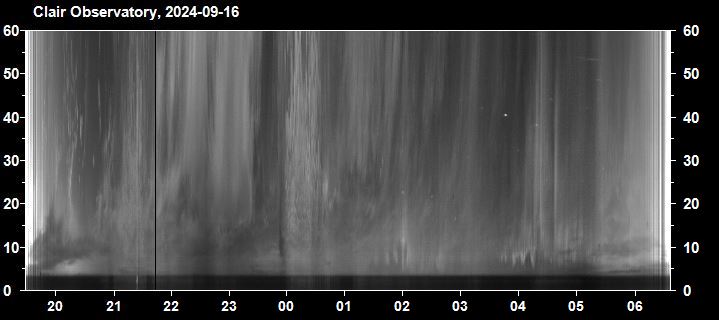 |
Back to Top
| Panoramic View - Northern Sky |
| 2024-09-17 00:28 UT (01:28 BST) Faint Auroral Activity at 5° altitude in N direction (Aurora difficult to see due to cloud and bright moonlit skies, Moon at 98% phase) |
 |
| 2024-09-17 00:53 UT (01:53 BST) Faint Auroral arc to 10° altitude (partly hidden) with moving curtains, Display continues to be affected by cloud & bright moonlit skies |
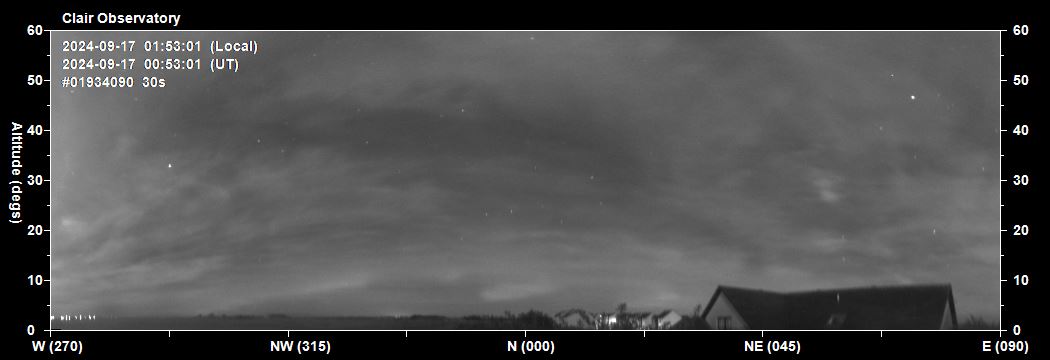 |
| 2024-09-17 01:01 UT (02:01 BST) Auroral arc with rays developing to 15° altitude, most prominant in NW direction |
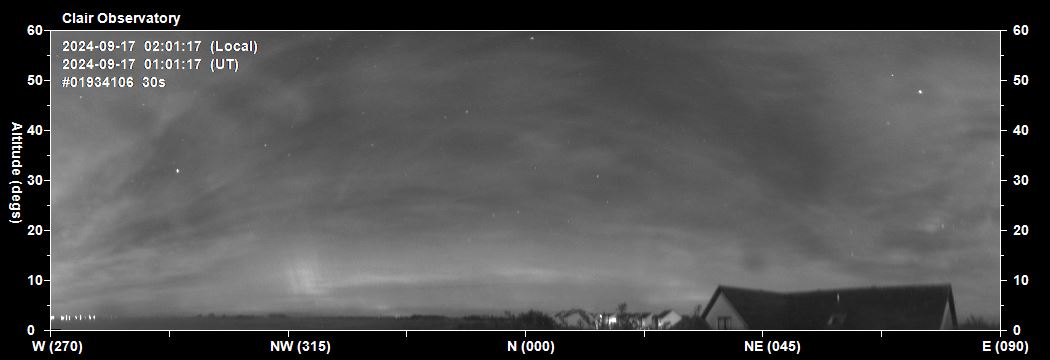 |
| 2024-09-17 01:04 UT (02:04 BST) Auroral rays to 30° altitude in NNW sky. Aurora brightest in NW-NNW direction Display continues to be affected by cloud & bright moonlit skies |
 |
| 2024-09-17 01:35 UT (02:35 BST) Auroral activity along northern horizon at 4-7° altitude (best seen in video) |
 |
| 2024-09-17 02:44 UT (03:44 BST) Auroral arc with undulating lower surface, likely curtains and very faint / barely visible rays |
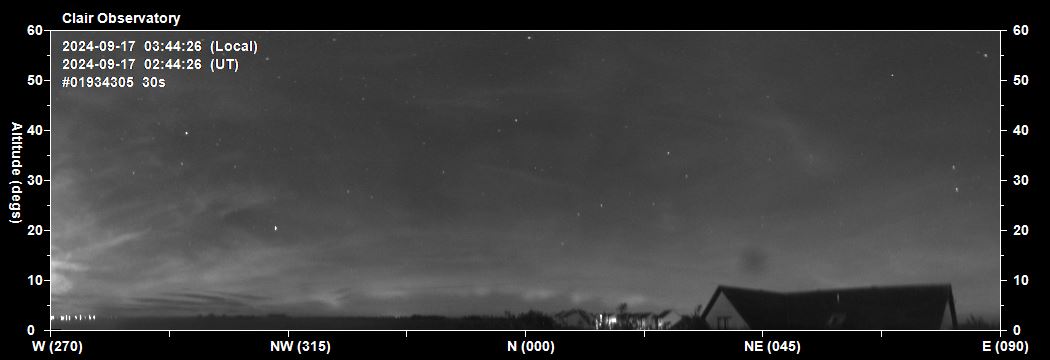 |
| 2024-09-17 03:00 UT (04:00 BST) Auroral arc brightening with distinct rays in NNE sky to 30° altitude |
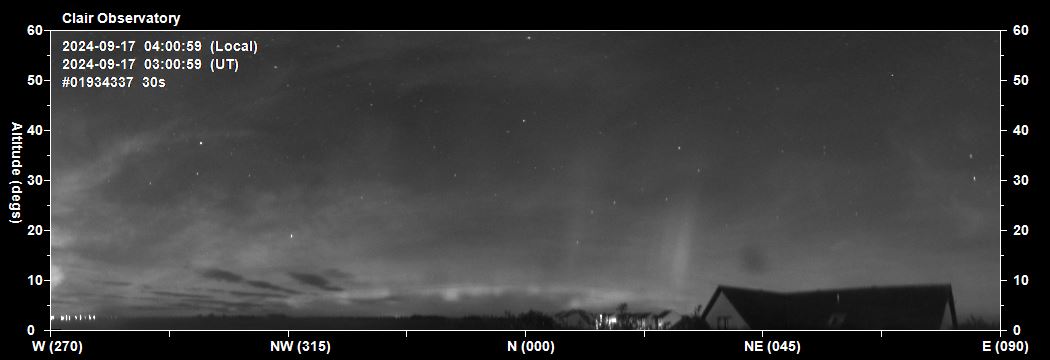 |
| 2024-09-17 03:12 UT (04:12 BST) Rays across northern sky ( WNW to NE) to 35° altitude |
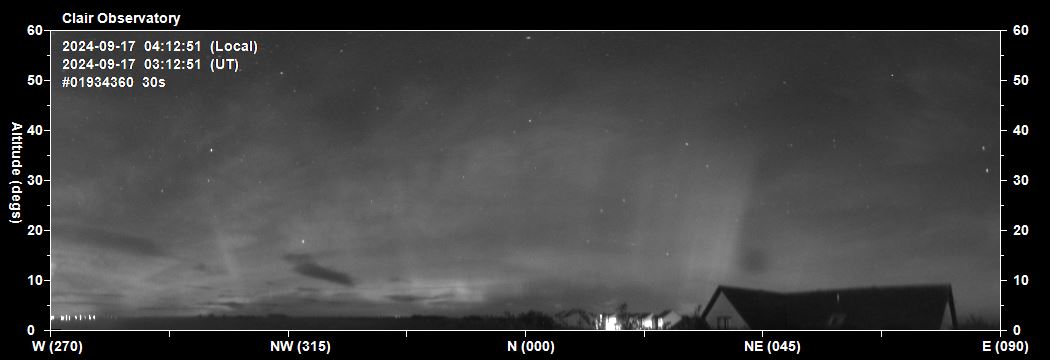 |
| 2024-09-17 03:19 UT (04:19 BST) Rays to 50° altitude in N sky, actively moving curtains |
 |
| 2024-09-17 03:23 UT (04:23 BST) Nice set of rays to 60° altitude, most prominant in NNE sky |
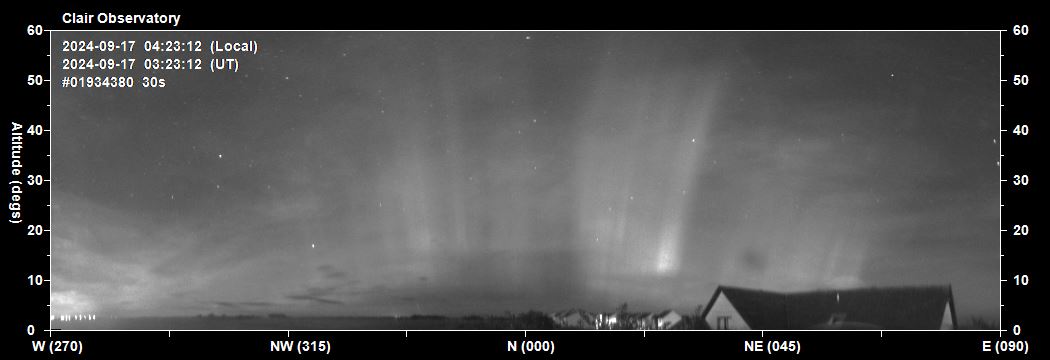 |
| 2024-09-17 03:24 UT (04:24 BST) Rays rapidly brightening in NNE sky |
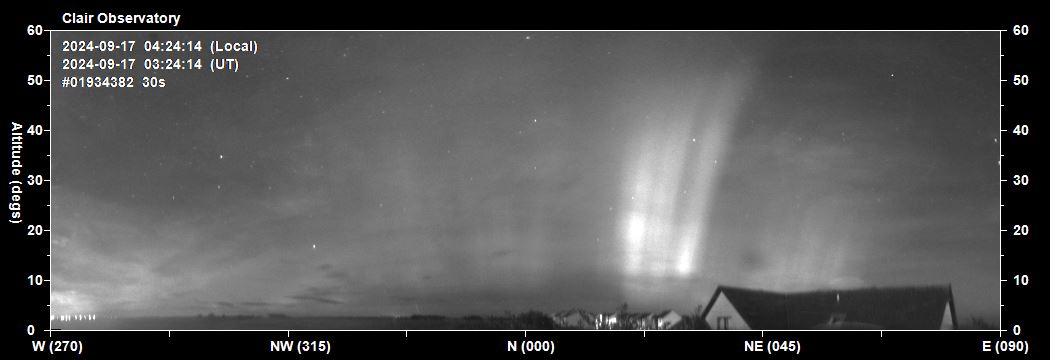 |
| 2024-09-17 03:38 UT (04:38 BST) Rays to 40° altitude in WNW to NE sky (most prominant in NW-N direction) |
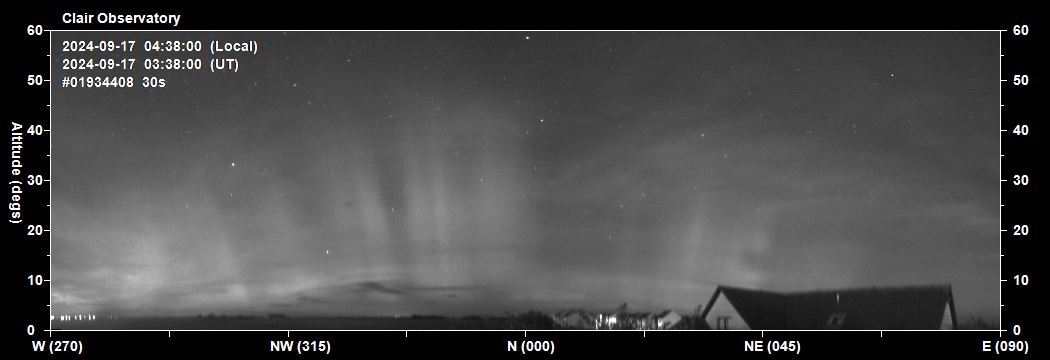 |
| 2024-09-17 04:02 UT (05:02 BST) Activity declining but aurora still visible in NNW to NE sky. Possible very faint rays to 30+° altitude |
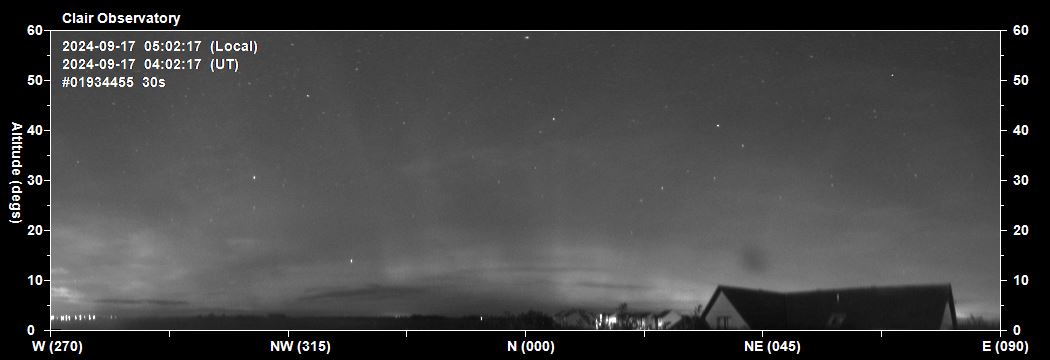 |
| 2024-09-17 04:19 UT (05:19 BST) Aurora still visible in NW-NNW sky. Very faint rays to 40° altitude Dawn twilight developing in NE-E sky |
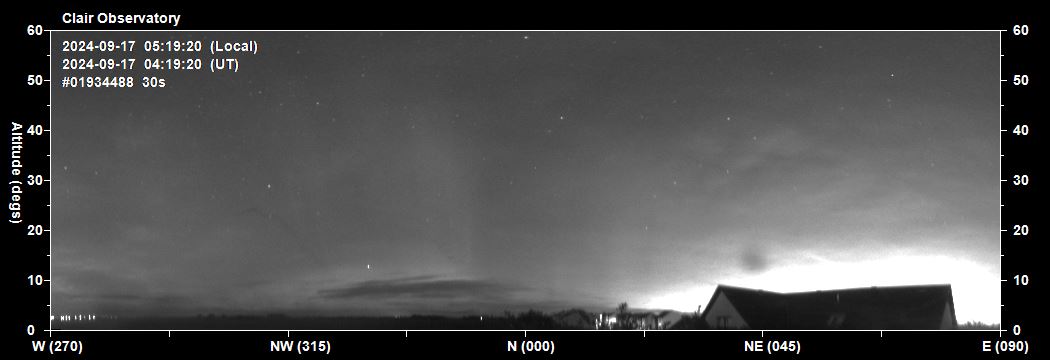 |
| 30s exposures taken with Oculus All Sky Camera |
Back to Top
| Video: North panoramic view, 4.5 hr period 2024-09-17 00:00 to 04:30 UT (01:00 to 05:30 BST) Frames #1933989 to 1934509 |
| Link to .mp4 video file (3.1 MB) |
|
0.0s
/ 0.0s
|
Back to Top
| Magnetometer Stack Plots from Scandinavia
(ordered by latitude) H Component - 2024-09-16 / 2024-09-17 Activity on 2024-09-16 between 01:00 and 04:15 UT with peak activity at around 01:00-01:45 UT Note: Geomagnetometer activity at rvk (Rorvik, 64.95N), dob (Dombas, 62.07N), sol (Solund, 61.08N) and kar (Karmoy, 59.21N) stations are used as indicators for potential auroral activity that may be visible from my Observatory situated at latitude 57.32N (Map of Stations) |
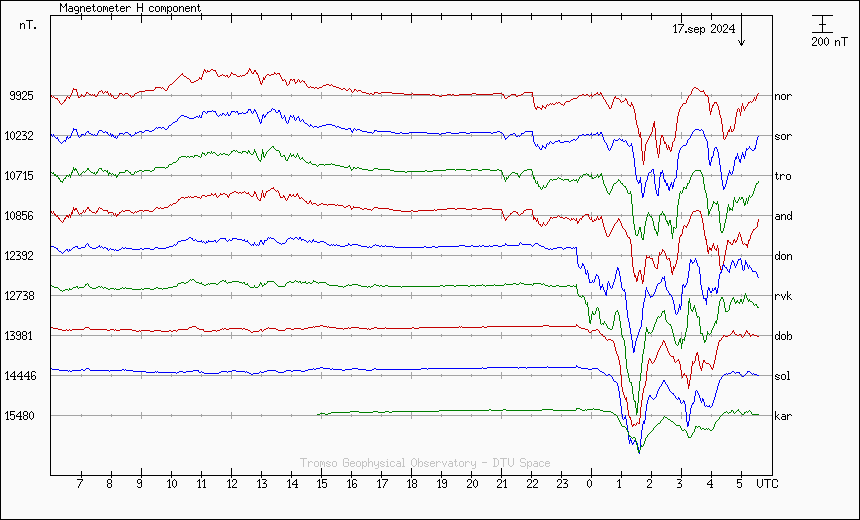 |
|
Graphed using 'make your own graph' facilities at
https://flux.phys.uit.no/compose/ (Tromsų Geophysical
Observatory ) Original data from Tromsų Geophysical Observatory (TGO), DTU Space (Technical University of Denmark) and Finnish Meteorological Institute (FMI) Data also displayed on SpaceWeatherLive's Europe Stackplot at http://www.spaceweatherlive.com/en/auroral-activity/magnetometers). |
Back to Top
|
Estimated 3 hour Planetary K-Index (NOAA) (from http://services.swpc.noaa.gov) Planetary-k-index_2024-09-16 / 2024-09-17 Not captured |
|
SAMNET's magnetometer at Crooktree, Near Torphins
(Chart
Explanation) - Magnetometer activity on the night 2024-09-16 / 2024-09-17. showing high activity between 00:00 & 05:00 UT, with peak at around 01:00 UT |
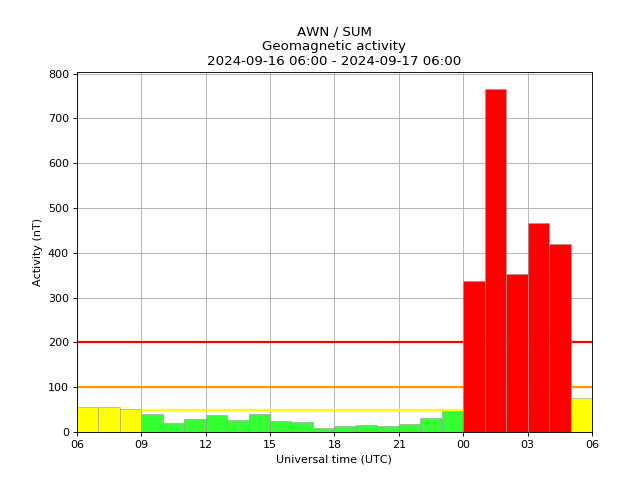 |
|
8-day Lerwick Observatory K Index Showing max KP7- KP8 on the night of 2024-09-16 / 2024-09-17 |
 |
|
Planetary K-Index and other information (Space Weather
Prediction Centre) shows KP Index reaching max KP7.5 on night of 2024-09-16 / 2024-09-17 |
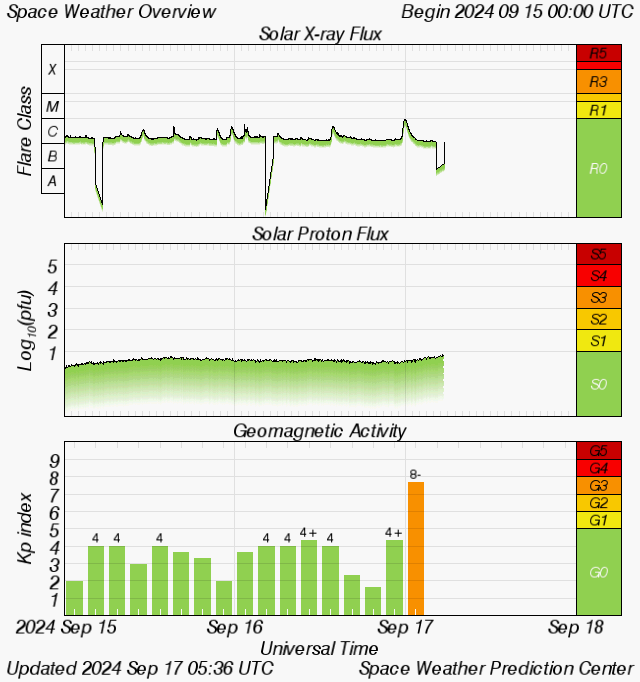 |
Back to Top
|
Aurora Forecast for 2024-09-17 01:48 UT (02:48 BST) (From Space Weather Prediction Centre, http://www.swpc.noaa.gov ) |
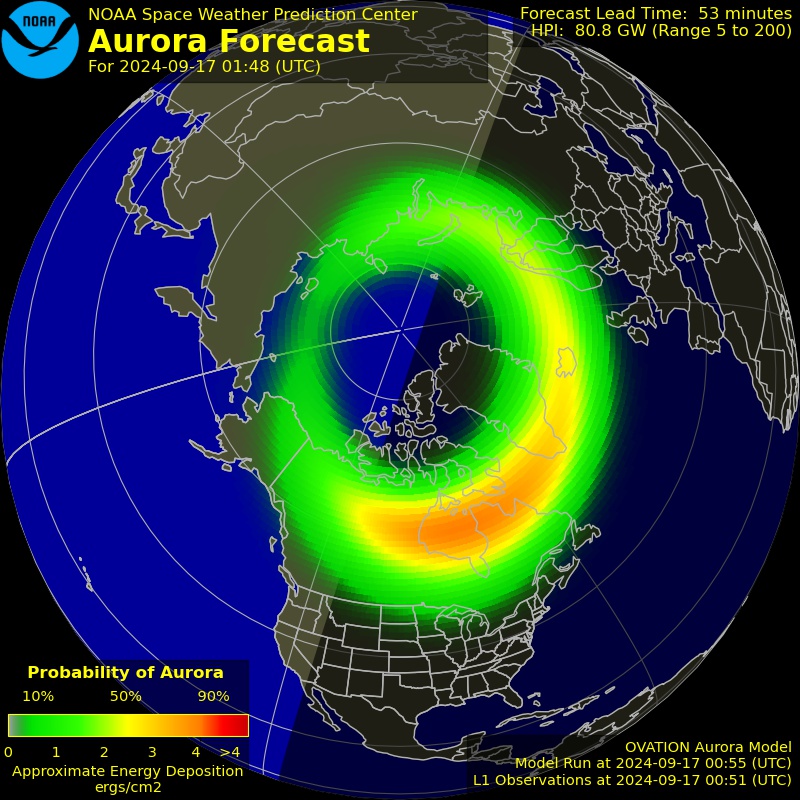 |
|
Aurora Forecast for 2024-09-17 03:43 UT (04:43 BST) (From Space Weather Prediction Centre, http://www.swpc.noaa.gov ) |
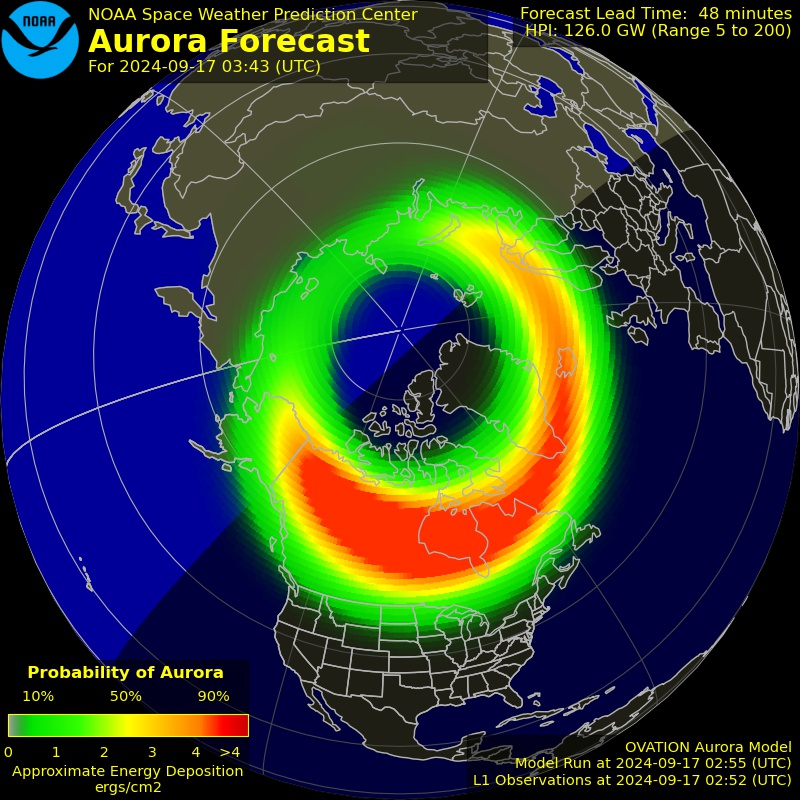 |
Back to Top
| This Web Page: | Aurora - 2024-09-16 / 2024-09-17 |
| Last Updated : | 2024-10-12 |
| Site Owner : | David Richards |
| Home Page : | David's Astronomy Web Site |